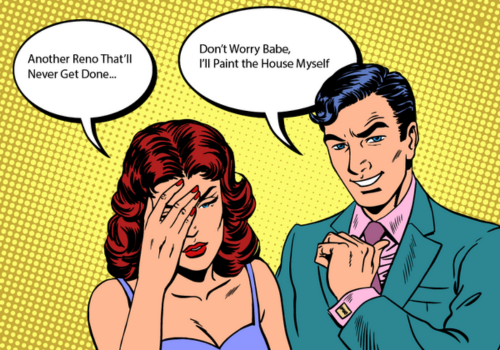A 403-PAINTER Guide to Tenting Before a Paint Job
When considering a home makeover or an upgrade, painting is one of the most impactful changes one can opt for. But how do you ensure that your painting job remains unaffected by external elements and results in a flawless finish? Enter the technique of tenting your home for painting.
Benefits of Tenting Your Home for Painting
Steps to Tent a Home for Painting
Common Mistakes and How to Avoid Them
By the end of this Blog, you will have all the knowledge and steps to ensure your home improvement job is completed to an expert degree.
Benefits of Tenting Your Home for Painting
Protection Against External Elements:
The random weather, especially in regions like Calgary, can greatly hinder the process of painting. One cannot control or predict when a sudden shower might occur or when gusty winds decide to make their presence felt.
Tenting acts as the ideal shield in such situations. Raindrops wont smudge, dilute, or wreck those fresh coats of paint.
Minimized Dust and Debris:
A freshly painted wall should gleam with the vibrancy of its new color. Dust and debris in the air can land on wet paint, making it feel rough and look less shiny.
Tack cloth and then tenting effectively seals off the painting environment, providing a barrier against these external contaminants. This ensures that the chosen paint color shines through in its pristine state.
Ensures Even Drying:
A consistently dried paint surface is crucial for aesthetic appeal, especially when engaging in intricate tasks like cabinet painting. Uneven drying, often caused by sporadic sun exposure or wind patterns, can lead to patchy areas or color discrepancies.
By tenting the home, you create a controlled environment that facilitates uniform drying, ensuring the paint’s true hue and texture manifest uniformly across the surface.
Safety and Cleanliness:
Overspray is often the bane of painters, particularly during detailed tasks like trying to paint your kitchen cabinets. The fine mist of paint can settle on unintended surfaces, leading to additional cleanup or damage.
Tenting minimizes this risk by containing the overspray within a defined area, ensuring that driveways, furniture, and other unaffected parts remain clean.
Steps to Tent a Home for Painting:
Assessment:
Before embarking on the painting journey, it’s pivotal to conduct a thorough evaluation of the home. This isn’t just about measuring dimensions.
Choosing the Right Materials:
Paint selection is more than just choosing between oil-based paints and latex paints. It’s about understanding the specific needs of the project.
Oil-based options are good for shiny, long-lasting finishes. However, they take longer to dry. Additionally, they require special materials for covering. This is necessary to allow for more time to cure.
Latex paints dry quickly and need materials to help them evaporate fast and avoid humidity buildup.
Setting Up the Tent:
Tent setup is a meticulous process. It isn’t just about coverage but ensuring every corner, from baseboards to peaks, is adequately protected.
Special attention is required for detailed jobs, like cabinet painting, where even a small exposure can lead to uneven painting or debris contamination.
Safety Measures:
Ventilation isn’t just for comfort; it’s a crucial safety aspect. Oil-based paints release solvents during the drying process, which can be harmful if inhaled in large quantities. The tenting setup should prioritize proper ventilation, ensuring that these fumes disperse quickly, safeguarding both the homeowner and the painter.
Cost Implications
Tenting a home for painting might initially raise eyebrows due to its cost, but a broader perspective reveals its intrinsic value:
Long-Term Savings:
While tenting comes with upfront costs, it eliminates frequent touch-ups and repairs due to external Impediments, thereby saving money in the long run.
Quality and Consistency:
Tenting ensures a flawless and consistent finish by preventing unexpected disruptions. This protection means that the initial cost can be more economical than facing rework expenses later on.
Property Value Enhancement:
A pristine paint job, ensured by tenting, can boost the property’s aesthetic appeal and its market value. This uplift makes the tenting investment worthwhile.
Transparent Pricing in Calgary:
For those in Calgary, engaging with a seasoned Calgary painter is beneficial. These professionals offer a transparent breakdown of costs, helping homeowners understand and appreciate the value of tenting their property for painting.
Common Mistakes and How to Avoid Them
Improper Setup:
It’s easy to overlook a small section during tent setup, but such oversights can compromise the entire painting job. Regularly inspect the tent to ensure complete coverage and secure all edges to prevent them from lifting due to wind or movement.
Inadequate Ventilation:
Good ventilation ensures the paint dries correctly, especially important for oil-based paints. Without proper circulation, the paint might not fully cure, leading to a less durable finish. Ensure that tenting materials and setup allow for a consistent airflow, and avoid painting on overly humid days.
Low-Quality Materials:
Skimping on quality can prove costly in the long run. Whether it’s the paint or the tenting material, quality directly influences the end result. Invest in premium paints that promise longevity and tenting materials known for durability and effectiveness.
Conclusion
Tenting your home for painting ensures that every inch, from your accent wall to your freshly painted drawer fronts, look perfect. Whether you’re diving into interior house painting or just touching up some spots, tenting should be a consideration. If you’re unfamiliar with the process or feel unsure, always trust professional painters to guide you through. After all, painting is not just about changing colors; it’s about ensuring the change lasts beautifully.
For those of you in Calgary or nearby regions, always opt for a reputed Calgary painter. The expertise they bring to the table, combined with the technique of tenting, will ensure your home looks as radiant as you envisioned.
FAQ
Yes, tenting moderates the effects of temperature, ensuring paint dries evenly and adheres well, whether in hot or cold conditions.
Absolutely. While commonly used outdoors, tenting can prevent dust and contaminants from settling on wet paint indoors, especially when painting cabinets.
The duration depends on the paint type and environmental conditions. Typically, a few hours to overnight is sufficient for most paints to dry without external interference.
Tenting can create a controlled environment, ensuring consistent drying. However, proper ventilation is essential, especially with oil-based paints, to allow solvents to evaporate and the paint to fully cure.


